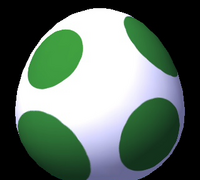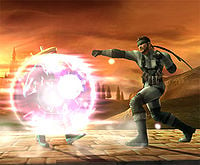Shield
- For the defensive shields used by the various versions of Link, see Shield (Link).
A shield is a bubble of energy encircling the user that blocks all attacks with the exception of grabs and Final Smashes. One raises the shield by pressing a shield button (Z in Super Smash Bros., L or R in Melee and Brawl) while standing on the ground. Shields cannot be held forever: they shrink as time passes and attacks are blocked, and break when held for too long (stunning the user, SDing Jigglypuff). Shields recharge when not in use.
Technical details
Though the shield blocks most attacks without fail and comes out at frame 1, their shrinking causes them to not always cover the character's entire damageable collision bubble - thus, the user is still vulnerable to shield stabbing.
If a projectile hits a shield at just the right angle, it will be deflected, rather than blocked. The initial raising of the shield creates a small energy wave; if that wave hits a projectile, it will be reflected.
When shielding in Melee, one can adjust the depression of the L or R button to alter the density of the shield. A light shield will cover a wider area and shrink more slowly than a dense shield, but the user will skid back a larger distance when hit. If one uses the Z button to shield, the shield will be maximum size, however this shield will take a bit longer to put up, as the character will try to grab first.
Interestingly, variable shield density has been removed from Brawl. Density was presumably removed because shielding can be assigned to buttons that aren't analog, as the GameCube Controller's L and R buttons are.
If a shield is fully raised and encircles an incoming attack, the attack will be Perfect Shielded.
It is possible to move while using a shield. This is called Dashing shield.
Certain attacks have increased shield damage, meaning that they deal more damage to shields than to other targets. The Fan is one example, whose smash attack can break a shield in one hit. Based on the extra damage done by these attacks (the highest known value being 42), it can be guessed that a full shield can withstand 50% damage.
Options from the shield
When holding their shield, characters do not have all the same options as they do while standing, but they are still able to use many moves. A character can roll to reposition themself while retaining invincibility. If a player predicts that the enemy will grab to penetrate their shield, they can quickly sidestep to avoid the grab. If the control stick is tilted slightly, the shield can be shifted slightly to help block attacks from specific directions if the shield gets too small.
Characters can also grab and jump out of their shield. Grabbing after blocking an attack is a prevalent technique known as shield grabbing - it allows one to quickly retaliate against an enemy attacker. Jumping from the shield allows characters to immediately shffl, wavedash or jump-cancel into their Up smash or Up Special Move. All these offensive and defensive options make shielding the centerpiece to a player's defensive game.

Yoshi's shield
Yoshi has a different shield from that of other characters'. Instead of using a bubble, he uses an egg for protection. This egg does not shrink, preventing any attempts at shield stabbing. Instead, as it weakens, the egg darkens from white to dark red (similar to the color of the percentage meters). The egg prevents Yoshi from jumping out of his shield or Glide Tossing, but when lightshielding, Yoshi will slide a huge distance when attacked (possibly across the entire stage). Also, Yoshi has been known to randomly Perfect Shield (not completely understood), and is also completely invincible during his shielding animation. Also, when Yoshi is in his shield and continuously rolls on the edge of the stage, the egg lightens up, restoring his shield, called Shield Restoring. Because Yoshi cannot jump out of his shield, and also because his shieldgrab is very slow, his out of shield game is much more limited than the rest of the cast, meaning that he has more trouble dealing with shield pressure.
Jigglypuff's shield
While having a very large shield compared to Jigglypuff's size, if Jigglypuff's shield breaks, it is knocked upward far higher than any other character, and if nothing stops it, Jigglypuff will self-destruct. This phenomenon is known as the Shield Jump and can be helpful sometimes.
Other notable shields
- Donkey Kong's Shield is known to be very small related to his size (though it's big), making him very easy to shield stab.
- Mr. Game and Watch in Melee suffers from the same problem as Donkey Kong and Pikachu. A shield which is much smaller than him, making it easy to stab and break.
- Pikachu is known for having the smallest shield size, making both easy shield stabbing and shield breaking.
Origin
The idea of blocking attacks originates from the "guarding" move from Kirby Super Star which could block most attacks by holding L or R; powerful attacks would still deal Kirby minimal damage but not cause him to flinch. In Smash Bros., Kirby's pose while shielding is identical to his guarding pose from Super Star. The design for the shield bubble also originates from Kirby Super Star. When Kirby guarded while possessing the Mirror ability, he could create a multi-colored ball around his body that would protect him from any attack (other than grabs), even reflecting some attacks. This shield was more effective than the guarding ability he normally had.
Yoshi's shield design, on the other hand, is possibly based on an occurrence in Yoshi's Island. When Baby Mario grabs a Super Star and starts running around, Yoshi follows by hiding in an egg and becoming part of his egg trail. The duo is invincible during this time. The shield may also be based on Yoshi becoming invincible once swallowing a Turbo Tulip in Yoshi's Story, although that is generally attributed to the Egg Roll instead. Why exactly Yoshi has a unique shield yet no other character does is a mystery.
Trivia
- Pikachu (SSB) will do its Star KO yell when its shield breaks.
